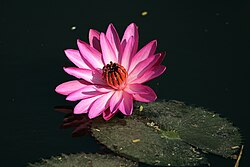Biology:Nymphaea rubra
| Nymphaea rubra | |
|---|---|

| |
| Nymphaea rubra flowering in Karikalampakkam, India | |
| Scientific classification | |
| Kingdom: | Plantae |
| Clade: | Tracheophytes |
| Clade: | Angiosperms |
| Order: | Nymphaeales |
| Family: | Nymphaeaceae |
| Genus: | Nymphaea |
| Species: | N. rubra
|
| Binomial name | |
| Nymphaea rubra Roxb. ex Andrews[2]
| |
| Synonyms[2] | |
| |
Nymphaea rubra is a species of waterlily native to the region spanning from Sri Lanka and northeastern India to western and central Malesia. Additionally, it has been introduced to regions such as Southeast China, Cuba, Guyana, Hungary, and Suriname.[2]
Description

Vegetative characteristics
Nymphaea rubra has 15.1 cm long, and 7.9 cm wide rhizomes.[3] The petiolate, orbicular leaves are 25–48 cm wide. The adaxial leaf surface is bronzy red to dark green, and the abaxial leaf surface is dark purple. The leaf venation is very prominent.[4] The petiole is 140 cm long.[3]
Generative characteristics
The flowers are 15–25 cm wide.[5] The four purplish-red sepals are oblong to lanceolate.[6] The 12-20 narrowly oval petals have a rounded apex. The androecium consists of 55 red stamens.[5] The gynoecium consists of 16-21 carpels.[6] The fruit bears 1.85 mm long, and 1.6 mm wide seeds.[5] The peduncle is 116 cm long.[3] The flowers are pleasantly fragrant.[7]
Cytology
The diploid chromosome count is 2n = 56.[3]
Reproduction
Vegetative reproduction
One case of the development of a proliferating pseudanthia has been reported for a Nymphaea rubra specimen cultivated in the Botanical Garden of the University of Heidelberg, Germany in 1886.[8]
Generative reproduction
Nymphaea rubra may reproduce an apomictically.[9]
Taxonomy
Publication
It was first named by William Roxburgh, but only later validly published by Henry Cranke Andrews in 1808.[2]
Placement within Nymphaea
It is placed in Nymphaea subgenus Lotos.[5]
Etymology
The specific epithet rubra means "red".[10][11]
Conservation
The IUCN conservation status is Least Concern (LC).[1]
Ecology

Habitat
It occurs in rivers, lakes, and ponds.[12]
Use
The peduncles, and seeds are used as food.[1]
Cultivation
It is suitable for the cultivation in aquaria.[13][1]
References
- ↑ 1.0 1.1 1.2 1.3 Juffe Bignoli, D. 2011. Nymphaea rubra. The IUCN Red List of Threatened Species 2011: e.T169021A6562659. https://dx.doi.org/10.2305/IUCN.UK.2011-1.RLTS.T169021A6562659.en. Accessed on 04 January 2024.
- ↑ 2.0 2.1 2.2 2.3 "Nymphaea rubra Roxb. ex Andrews" (in en). Royal Botanic Gardens, Kew. http://www.plantsoftheworldonline.org/taxon/605694-1. Retrieved 4 January 2024.
- ↑ 3.0 3.1 3.2 3.3 Hossain, A.; Kabir, G.; Ud-deen, M. M.; Alam, A. M. S. (2007). "Cytological studies of Nymphaea species available in Bangladesh". Journal of Bio-Science: 7–13. ISSN 1023-8654. https://citeseerx.ist.psu.edu/document?repid=rep1&type=pdf&doi=8dae6487226a6e4fa9ae66c759bb89878b6c77c7..
- ↑ Guruge, D. S. K.; Yakandawala, D.; Yakandawala, K (2016), "Confirming the identity of newly recorded Nymphaea rubra Roxb. ex Andrews discerning from Nymphaea pubescens Willd. using morphometrics and molecular sequence analyses.", Bangladesh Journal of Plant Taxonomy 23 (2), http://aquaria.palo-alto.ca.us/plants/n/Nymphaea/rubra/Confirming_the_identity_of_newly_recorded_Nymphaea.pdf
- ↑ 5.0 5.1 5.2 5.3 Conard, H. S. (2015). The Waterlilies: A Monograph of the Genus Nymphaea (Classic Reprint). pp. 199-200. USA: FB&C Limited.
- ↑ 6.0 6.1 La-ongsri, W.; Trisonthi, C.; Balslev, H (2009), "A synopsis of Thai Nymphaeaceae", Nordic Journal of Botany 27 (2): 97–114, https://www.academia.edu/download/53868440/j.1756-1051.2009.00295.x20170715-15689-lsccl3.pdf
- ↑ Henkel, F.; Rehnelt, F.; Dittmann, L. (1907), Das Buch der Nymphaeaceen oder Seerosengewächse, p. 72, https://archive.org/details/Henkel_Nymphaeaceen/page/n73/mode/1up
- ↑ Franz Bleisch. (1886). "Abnorme Blüte von Nymphaea rubra." Deutsches Magazin Für Garten- Und Blumenkunde, 39, 326.
- ↑ Wiersema, J. H. (1988). Reproductive Biology of Nymphaea (Nymphaeaceae). Annals of the Missouri Botanical Garden, 75(3), 795–804. https://doi.org/10.2307/2399367
- ↑ Joe, A.; Sreejith, P. E.; Sabu, M. (2016). "Notes on Musa rubra Kurz (Musaceae) and reduction of M. laterita Cheesman as conspecific.". Taiwania 61 (1): 34–40. https://www.researchgate.net/profile/Alfred-Joe/publication/298791694_Notes_on_Musa_rubra_Kurz_Musaceae_and_reduction_of_M_laterita_Cheesman_as_conspecific/links/56ec085008aed740cbb60e31/Notes-on-Musa-rubra-Kurz-Musaceae-and-reduction-of-M-laterita-Cheesman-as-conspecific.pdf.
- ↑ Dictionary of Botanical Epithets. (n.d.-b). Retrieved January 4, 2024, from http://botanicalepithets.net/dictionary/dictionary.159.html
- ↑ Nymphaea rubra Roxb. ex Salisb. (n.d.). India Biodiversity Portal. Retrieved January 4, 2024, from https://indiabiodiversity.org/species/show/230505
- ↑ Nymphaea rubra - Rote Seerose. (n.d.). Flowgrow. Retrieved January 4, 2024, from https://www.flowgrow.de/db/wasserpflanzen/nymphaea-rubra
Wikidata ☰ Q13059511 entry
 |


